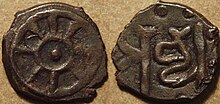Ahichchhatra
 One of the Shiva temple ruins at Ahichhatra . | |
| Location | Uttar Pradesh, India |
|---|---|
| Coordinates | 28°22′16″N 79°08′10″E / 28.371°N 79.136°E |
| Type | Temples |
| History | |
| Founded | c. 1500 BCE |
| Cultures | Ochre Coloured Pottery culture, Black and red ware, Painted Grey Ware culture, Gupta Empire |
Ahichchhatra or Ahikhet (
A Most of the city was half a mile north-east of the modern village, with a large mound, popularly called the fort, two miles west of this. Several significant finds of sculpture, in both stone and (especially) terracotta of the early centuries CE, have been made at the site and are now in various museums. Excavations have uncovered nine strata, the lowest from before the 3rd century BCE and the latest from the 11th century CE.[3] Ashwatthama was the king of Ahichchhatra during Mahabharata time. The city appears to have reached its height during the period of the
Names
The word Ahi means snake or Naga in Sanskrit. Nagas were a group of ancient people who worshiped serpents. The word khsetra means region in Sanskrit. This implies that Ahi-kshetra was a region of Nagas.
Vividha Tirtha Kalpa, composed by Jain Acharya Jinaprabha Suri in the 14th century CE, mentions Samkhyāvatǐ as the earlier name of Ahichchhatra and describes two Jain temples dedicated to Parshvanatha in the area. Ahikshetra is mentioned as Shankavai Samkhyavati in Vividhatirthakalpa.[5]
History
According to Jain Tradition, the history of Ahichchhatra traditionally starts from the period of
Its history reaches back to late
The last independent ruler of Ahichatra was Achyuta Naga, who was defeated by Samudragupta, after which Panchala was annexed into the Gupta Empire.[9] The coins of Achyuta found from Ahichatra have a wheel of eight spokes on the reverse and the legend Achyu on the obverse.[10]
Archaeology
The site was briefly explored by Sir
In the early Gupta period a section of the city set aside for pottery contained very large firing pits, some 10 or 12 feet deep.[14]
Jain tradition



Ahichchhatra is believed to be the place where
Means of approach
From the Revati Bahoda Khera Station on Chandosi – Bareilly Line, vehicle of Kshetra and other vehicles are available. Road: - Buses are available from Delhi, Meerut, Aligarh, Lucknow, Kasganj & Badaun. Train: - Trains are available from Delhi, Bareilly, Agra, Moradabad, Aligarh to Revati Bahoda Khera Station and vehicles are all time available for Ramnagar from Revati Bahoda Khera Station. Airport: - Delhi 250 km
Nearby Places
Nainital – 180 km Hastinapur Atishaya Kshetra – 200 km Kampilji Atishaya Kshetra – 180 km Manglayatan (Aligarh) – 180 km Bareilly – 55 km
Sculpture from Ahichchhatra
-
23rd Tirthankara Parshvanatha sculpture excavated from Ahichchhatra, 7th century BCE
-
Stone Buddha, c. 1st Century CE, Kushan Period
-
Sandstone Shiva, 3rd century
-
Terracotta architectural panel with Goddess, Gupta period, 5th century
-
Gupta period terracotta Yamuna, pair to the Ganga above
Notes
- ISBN 978-0-300-06217-5.
- ISBN 978-81-7335-498-4.
- ^ a b Kala, p. xv
- ^ Majumdar, 429-430
- ^ Subodh Kapoor 2002, p. 16.
- ^ "Brochure Ahicchatra" (PDF). Archived from the original (PDF) on 25 May 2022. Retrieved 20 April 2022.
- ISBN 978-81-7755-298-0.
- ^ Subodh Kapoor 2002, pp. 17–19.
- ^ Raychaudhuri, H.C. (1972). Political History of Ancient India, Calcutta: University of Calcutta, p.473
- ^ Lahiri, B. (1974). Indigenous States of Northern India (Circa 200 B.C. to 320 A.D.) , Calcutta: University of Calcutta, p.182
- ^ Lahiri, Bela (1972). Indigenous States of Northern India (Circa 200 B.C. to 320 A.D.), Calcutta: University of Calcutta, pp.170-88
- ^ "What Lies Beneath".
- ^ http://www.educationtimes.com/article/290/20130917201309171524062507304cdb3/What-Lies-Beneath.html What lies Beneath, B. R. Mani 2013
- ^ Majumdar, 430
- ^ UP tourism & Ahicchatra, p. 2.
- ^ Jain 2008, p. 64.
- ^ a b UP tourism & Uttar Pradesh: A to Z, p. 31.
- ^ UP tourism & Year-wise Tourist Statistics.
References
- Kala, Satish Chandra, Terracottas in the Allahabad Museum, p. xv, Abhinav Publications, 1980, ISBN 0391022342, 9780391022348, google books
- Kapoor, Subodh, ed. (2002), Encyclopaedia of Ancient Indian Geography, vol. 1, Cosmo Publications, ISBN 81-7755-298-8
- Jain, Lakshmi (2008). Dropout of Girl-child in Schools. Northern Book Centre. ISBN 9788172112448.
- Majumdar, Ramesh Chandra, Vakataka – Gupta Age Circa 200-550 A.D., 1986, Motilal Banarsidass Publ., ISBN 8120800265, 9788120800267, google books
- Uttar Pradesh Tourism
- Uttar Pradesh Tourism. "Uttar Pradesh: A to Z" (PDF). Uttar Pradesh Tourism.
- Uttar Pradesh Tourism. "Year-wise Tourist Statistics". Uttar Pradesh Tourism.
- Uttar Pradesh Tourism. "Ahicchatra" (PDF). Uttar Pradesh Tourism. Archived from the original (PDF) on 25 May 2022. Retrieved 20 April 2022.







